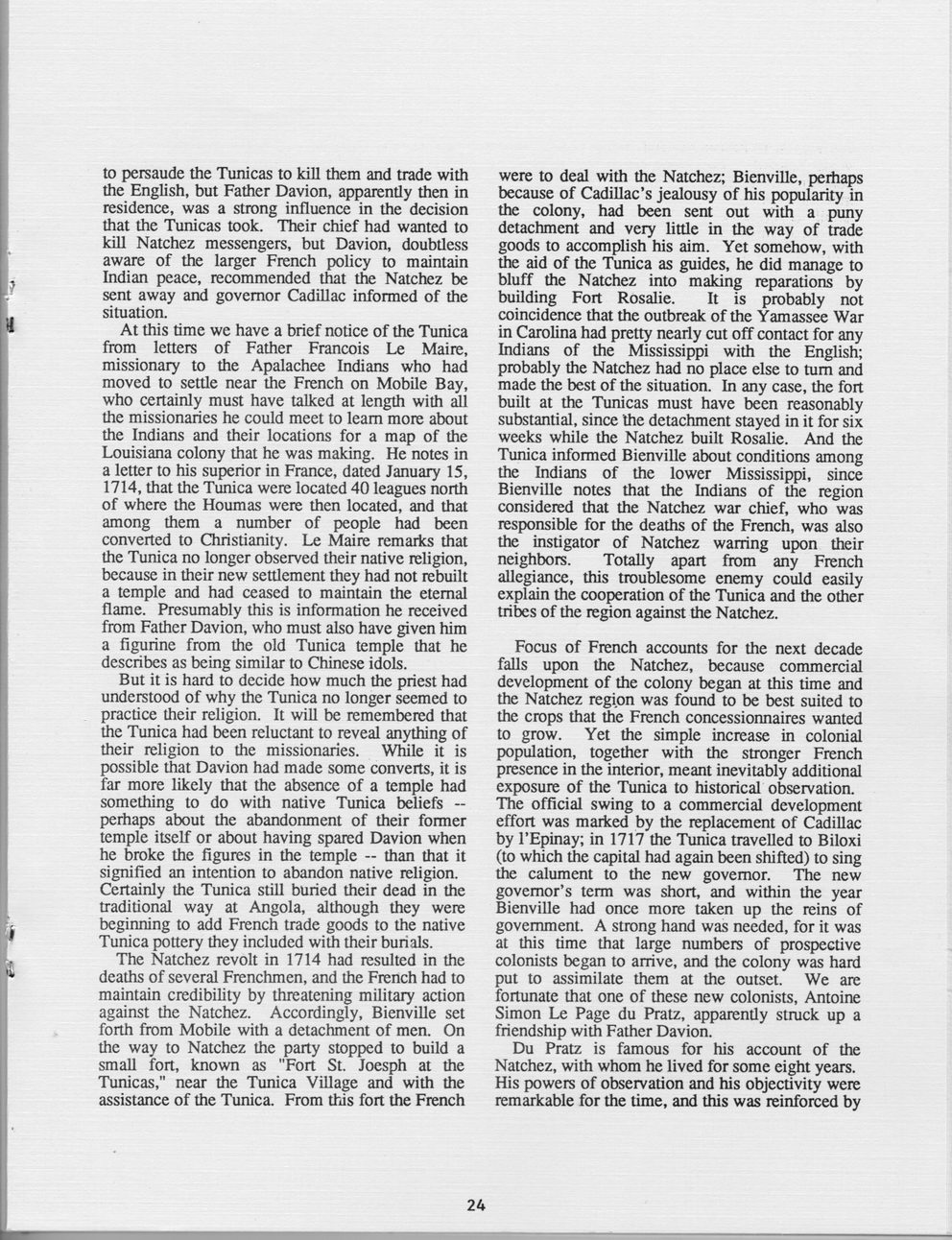This text was obtained via automated optical character recognition.
It has not been edited and may therefore contain several errors.
to persaude the Tunicas to kill them and trade with the English, but Father Davion, apparently then in residence, was a strong influence in the decision that the Tunicas took. Their chief had wanted to kill Natchez messengers, but Davion, doubtless aware of the larger French policy to maintain Indian peace, recommended that the Natchez be sent away and governor Cadillac informed of the situation. At this time we have a brief notice of the Tunica from letters of Father Francois Le Maire, missionary to the Apalachee Indians who had moved to settle near the French on Mobile Bay, who certainly must have talked at length with all the missionaries he could meet to learn more about the Indians and their locations for a map of the Louisiana colony that he was making. He notes in a letter to his superior in France, dated January 15, 1714, that the Tunica were located 40 leagues north of where the Houmas were then located, and that among them a number of people had been converted to Christianity. Le Maire remarks that the Tunica no longer observed their native religion, because in their new settlement they had not rebuilt a temple and had ceased to maintain the eternal flame. Presumably this is information he received from Father Davion, who must also have given him a figurine from the old Tunica temple that he describes as being similar to Chinese idols. But it is hard to decide how much the priest had understood of why the Tunica no longer seemed to practice their religion. It will be remembered that the Tunica had been reluctant to reveal anything of their religion to the missionaries. While it is possible that Davion had made some converts, it is far more likely that the absence of a temple had something to do with native Tunica beliefs -perhaps about the abandonment of their former temple itself or about having spared Davion when he broke the figures in the temple — than that it signified an intention to abandon native religion. Certainly the Tunica still buried their dead in the traditional way at Angola, although they were beginning to add French trade goods to the native Tunica pottery they included with their burials. The Natchez revolt in 1714 had resulted in the deaths of several Frenchmen, and the French had to maintain credibility by threatening military action against the Natchez. Accordingly, Bienville set forth from Mobile with a detachment of men. On the way to Natchez the party stopped to build a small fort, known as "Fort St. Joesph at the Tunicas," near the Tunica Village and with the assistance of the Tunica. From this fort the French were to deal with the Natchez; Bienville, perhaps because of Cadillac’s jealousy of his popularity in the colony, had been sent out with a puny detachment and very little in the way of trade goods to accomplish his aim. Yet somehow, with the aid of the Tunica as guides, he did manage to bluff the Natchez into making reparations by building Fort Rosalie. It is probably not coincidence that the outbreak of the Yamassee War in Carolina had pretty nearly cut off contact for any Indians of the Mississippi with the English; probably the Natchez had no place else to turn and made the best of the situation. In any case, the fort built at the Tunicas must have been reasonably substantial, since the detachment stayed in it for six weeks while the Natchez built Rosalie. And the Tunica informed Bienville about conditions among the Indians of the lower Mississippi, since Bienville notes that the Indians of the region considered that the Natchez war chief, who was responsible for the deaths of the French, was also the instigator of Natchez warring upon their neighbors. Totally apart from any French allegiance, this troublesome enemy could easily explain the cooperation of the Tunica and the other tribes of the region against the Natchez. Focus of French accounts for the next decade falls upon the Natchez, because commercial development of the colony began at this time and the Natchez region was found to be best suited to the crops that the French concessionnaires wanted to grow. Yet the simple increase in colonial population, together with the stronger French presence in the interior, meant inevitably additional exposure of the Tunica to historical observation. The official swing to a commercial development effort was marked by the replacement of Cadillac by l’Epinay; in 1717 the Tunica travelled to Biloxi (to which the capital had again been shifted) to sing the calument to the new governor. The new governor’s term was short, and within the year Bienville had once more taken up the reins of government. A strong hand was needed, for it was at this time that large numbers of prospective colonists began to arrive, and the colony was hard put to assimilate them at the outset. We are fortunate that one of these new colonists, Antoine Simon Le Page du Pratz, apparently struck up a friendship with Father Davion. Du Pratz is famous for his account of the Natchez, with whom he lived for some eight years. His powers of observation and his objectivity were remarkable for the time, and this was reinforced by 24

Native Americans The-Tunica-Biloxi-Tribe-its-Culture-and-People-(32)